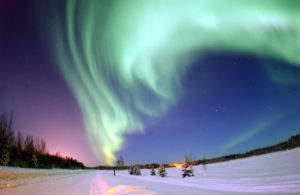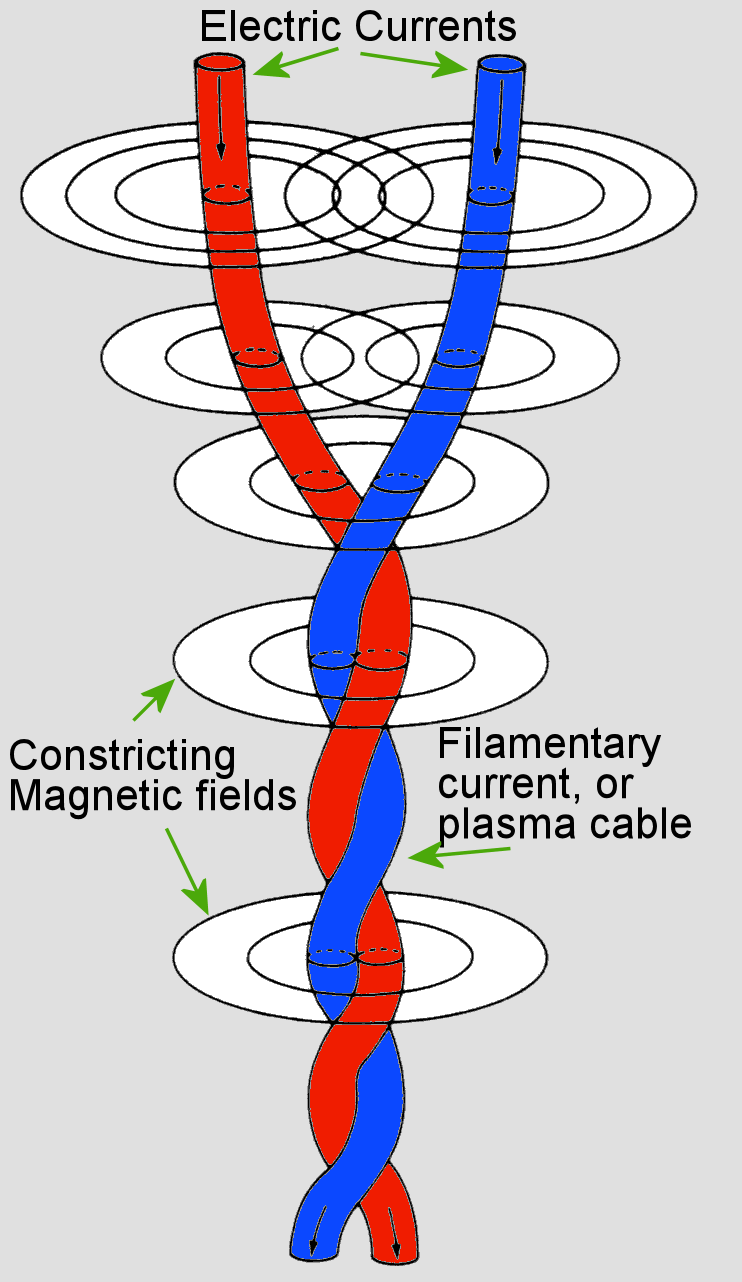Filamentation (or filamentary structure) is often seen in plasmas. It is created because plasma contains free electrons, making it highly electrically conductive — even more than metals, and even in tenuous cosmic plasmas. As charged particles readily move in a plasma, a ring of magnetic field forms around the current that can pinch it into filamentary current strands (ie. pinched filaments).[2]
Filamentary currents may also be formed alongside double layers (which further accelerate charge particles), and if the resulting electrons approach relativistic velocities (ie. the speed of light) and if they encounter a magnetic field, they will spiral and emit synchrotron radiation that includes radio, optical (ie. light), x-rays, and gamma rays. Filamentation may also cause chemical separation of elements through Marklund convection.
The magnetic fields generated by parallel filaments may cause them to bunch together, though if the currents are flowing in opposite direction, the filaments will repel one another.
Plasma filaments are also called Birkeland currents, “field aligned currents“, “plasma rope“, “plasma cables“, “flux ropes, “current constrictions“, and “plasma rays“.
Hannes Alfvén argued that the spontaneous formation of current filaments is a fundamental feature of magnetized plasmas in the laboratory as well as in space.[3]
Filaments in cosmic plasma
Plasma filaments are seen in:
- The aurora, forming curtains of filaments (ie, current sheets)
- The ionosphere of Venus, (once referred to as “stringy things”)
- The Sun, as prominences, spicules, coronal streamers, polar plumes, etc, [4]
- Cometary tails
- The Interstellar Medium
- In nebulae (ie interstellar clouds),[5]
- On Jupiter’s moon, Io.[6]

Footnotes
- ↑ Hannes Alfvén, Cosmic Plasma, (1981). Astrophysics and Space Science Library, Vol. 82 (1981) Springer Verlag. ISBN 90-277-1151-8. ACADEMIC BOOK
- ↑ A. L. Peratt, Physics of the Plasma Universe, Appendix C. Dusty and Grain Plasmas, (Springer, 1992) ISBN 0-387-97575-6 ACADEMIC BOOK
- ↑ “Alfvén has long and correctly argued [19] that the spontaneous formation of current filaments (“magnetic ropes,” “current constrictions,” “plasma rays,” etc.) is a fundamental feature of magnetized plasmas in the laboratory
as well as in space. His explanation for this, including the magnetic pinch effects and the usual Bennett relation
NkBT = µ0 I2/8π (31) was shown not to be convincing [20]. N and T are the line density and average particle temperature of the “rope,” respectively, and I is the total axial current flowing in it. However, Alfvén’s general views can be proved to be both correct and convincing by replacing (31) by the generalized Bennett relation [21].” E.A. Witalis, “Hall Magnetohydrodynamics and Its Applications to Laboratory and Cosmic Plasma” (1986) IEEE Transactions on Plasma Science (ISSN 0093-3813), vol. PS-14, Dec. 1986, p. 842-848. PEER REVIEWED. See also: Ref [19]: H. Alfven, Cosmic Plasma. Dordrecht, Holland: Reidel, 1981. ACADEMIC BOOK Ref [20]: R. M. Kulsrud, “Reviews of ‘Cosmic Plasma’ by H. Alfven,” Phys. Today, vol. 36, pp. 56-57, Apr. 1983. Ref [21]: E. A. Witalis, “Plasma-physical aspects of charged-particle beams,” Phys. Rev., vol. A24, pp. 2758-2764, 1981. PEER REVIEWED - ↑ Alfvén, Hannes, “On the Filamentary Structure of the Solar Corona“, The Solar Corona; Proceedings of IAU Symposium no. 16 held at Cloudcroft, New Mexico, U.S.A. 28-30 August, 1961. Edited by John Wainwright Evans. International Astronomical Union. Symposium no. 16, Academic Press, New York, 1963., p.35 FULL TEXT
- ↑ Dahlgren, Hanna; Carlqvist, Per; Gahm, Gösta F., “Filamentary structures in planetary nebulae” (2007) Astrophysics and Space Science, Volume 310, Issue 1-2, pp. 65-72 PEER REVIEWED. See also: Hanna Dahlgren: “Filamentary structures in planetary nebulae” (PDF), 2006-07-04, Seminar, Space & Plasma Physics, Royal Institute of Technology, Stockholm
- ↑ Peratt, Anthony L.; Dessler, A. J., “Filamentation of volcanic plumes on the Jovian satellite Io” FULL TEXT, Astrophysics and Space Science (ISSN 0004-640X), vol. 144, no. 1-2, May 1988, p. 451-461. PEER REVIEWED
References
- Peratt, A. L., “Plasma and the Universe: Large Scale Dynamics, Filamentation, and Radiation” FULL TEXT, Astrophysics and Space Science, v. 227, p. 97-107 PEER REVIEWED
